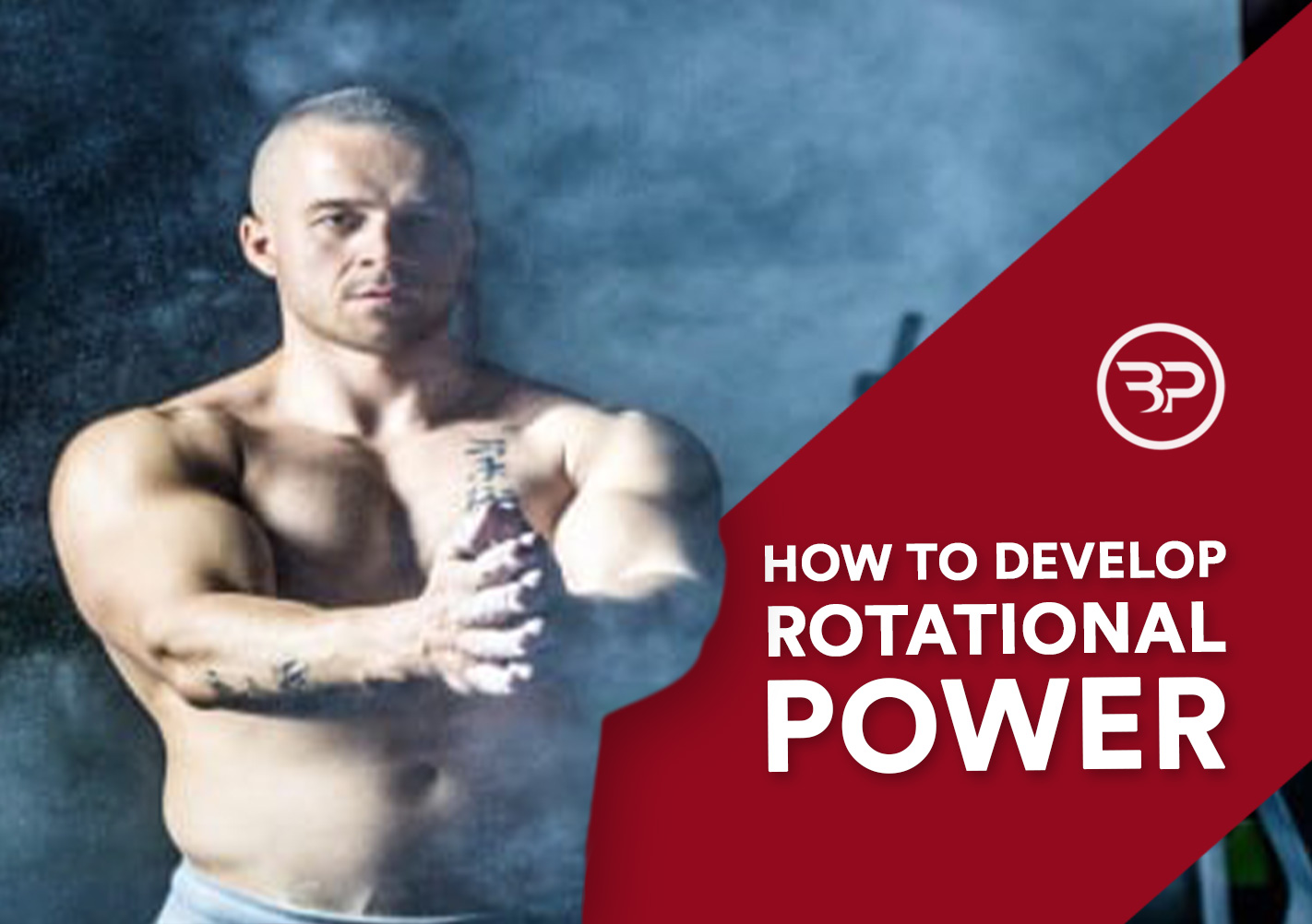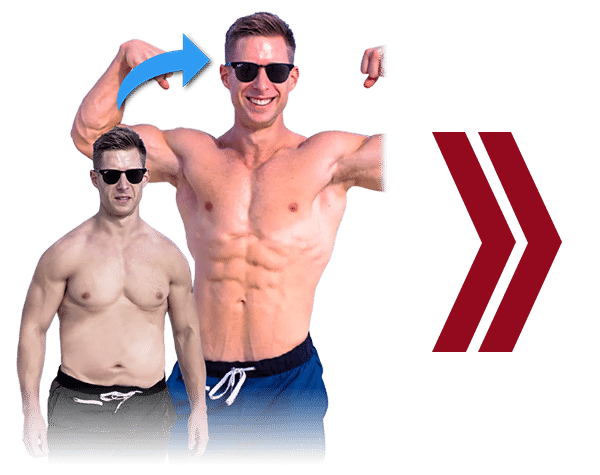How to Develop Rotational Power
February 25, 2016
What is rotational power? And why is it important for athletes, trainers, and people who want to improve their athleticism?
Kennet Waale explains in this extended guest post that comes complete with videos, tutorials, and a sample workout.
Over to you, Kennet.
Developing rotary power can improve hitting real world strength, overall athleticism, agility, and even straight-line sprinting speed.
Yet it is neglected. What gives?
All movements involve some level of rotation.
This happens either through a concentric muscular contraction creating the rotation like a swing, or by controlling the movements in an eccentric manner followed by an isometric contraction. The ability to create and transfer these forces come from efficient movement and the ability to disassociate and integrate the torso and hips at the right times.
Why The Consensus Is Wrong
There’s a common belief that improvements in the gym will lead to improvements on the track or field, or in daily living. This will happen in an exponential and linear way. All that’s needed is strength exercise, which will be highly transferable.
There is some truth to this. But there is also an unfortunate reality: the exercises we perform in the gym in no way replicate how power and forces are often created on the athletic playing field (Shepherd 2004; Siff et al. 1998).
But it’s complicated.
If you are an Olympic weightlifter or a powerlifter, the transferability from strength exercise to your sport is obviously high. On the flip side, planning is tricky when dealing with rugby or soccer players who run a lot and have frequent changes of direction.
Questions To Consider
How do you get strong?
Improve motor unit and muscle fiber recruitment (using more muscle fibers) and improve technique.
This increases your ability to produce force and hoist bigger weights. But would this be a worthwhile endeavor from a pure power production point of view if, for instance, an athlete couldn’t transfer the added strength into his sprinting technique?
Would getting stronger in big lifts like the squat really make performance that much better if it didn’t improve sprinting technique?
Consider these questions:
- Does the athlete have to overcome a large initial load such as a second rower in Rugby? Or an American example, is this person a lineman and has to overcome a defensive lineman?
- Is the athlete a 100m sprinter and only has to overcome gravity – bodyweight and some frictional forces?
- Do you play golf or baseball, where you need rotational power and strength?
- What is the predominant energy system requirement – is it ATP-PCr or Aerobic? Basically, do you play explosive sports or longer-duration sports?
Strength and power production are important. But past a certain baseline level, they won’t improve performance unless they are sport-specific.
Stability, general strength and pure rotary movement exercises are all important components of developing rotary power. This can be done through the use of various tools such as bodyweight, cable machines, resistance bands, kettlebells and barbells.
Disassociation of the Thorax and Hips
Disassociation is the ability to separate two corresponding regions of the body. The movements needed to produce rotational power (i.e in golf and baseball) come from adequate levels of disassociation.
Athletes who know how to disassociate the torso and the hips will increase the distance between the shoulders and hips as they turn.
This will maximize the rotational components and allow for powerful coiling and acceleration of the body for better power performance.
Disassociation without the ability to fully control acceleration and deceleration will not improve performance. It is therefore of utmost importance that you pay attention to integrating the torso and hips, too.
Use these two drills to improve your disassociation.
Torso
Integration of the Thorax and Hips
Efficient force transmission is a key component for power development.
Integration of the body can be as simple as practicing technique, like swinging a baseball bat to help the muscles used in rotation fire together faster and more efficiently.
Have you ever seen Charles Barkley’s’ excuse for a golf swing?
That’s poor dissociation–highlighting a need for better movement efficiency.
For Fitness Nerds Only: A Graph!
I was first introduced to the concept shown in the graph below while I was still at university. It describes the stimulus, recovery and adaptation over time for various aspects of training.

Curve 1 in blue describes technique training. This would be considered to be higher skill and low intensity for beginners, and lower skill and low intensity for those more rounded. The recovery time is short and the adaptations take place with little to no recovery needed (due to the little demand from external loads.)
Curve 2 in red describes hypertrophy training. This requires slightly more external load and volume. Technique is still an important focus, but the recovery time is slightly longer due to the increased intensity and volume. This makes the second curve either a lower skill and high intensity, or higher skill and low intensity. It depends on the level of development of the client. The recovery time is slightly longer and the frequency is set to 2-4 days per week.
Curve 3 in green describes maximal neural output and force production. The curve requires a high-intensity level and can be classified due to the recovery time from the stimulus. Depending on the level of development and sport at hand, this can be either classified as a high skill and high intensity or lower skill and high-intensity curve.
Building Anti-Rotation and Rotational Stability
Stability is a key component in maximizing efficiency of movement. Many of the people who walk through the doors at our facility partake in a rotary activity. Brazilian Jiu Jitsu or Rugby athletes are two examples. But, everyday folks training move and look better naked also experience rotation daily and must be stable to prevent injury.
Beyond injury prevention, we want to improve force transmission from head to toe throughout your body.
This helps you maximize power in rotational movements like a golf swing.
But there’s a catch: You must first be stable to prevent rotation before maximizing rotational power.
Below is a list of exercises that you could implement to maximize the stability foundation. If short on time – these are also excellent fillers in between other main exercises
Supine Exercises:
Cry Babies
1/4 Turkish Get Ups
Quadruped Exercises:
Bird Dog w/Cone
Bear Crawls w/Cone
Sidelying Exercise: Sidelying Pretzel Presses
Bridging Exercises: 1/2 Turkish Get Ups
Glute Bridge Marches
1/2 Kneeling Exercises:
Half Kneeling Cable Chop
Tall Kneeling Exercises: Tall Kneeling Pallof Presses, Tall Kneeling
Medicine Ball Chops and Lifts
Half Kneeling Isohold
Bilateral Exercises: Pallof Presses, Figure-X Pallof Presses
Unilateral Exercises:
1-Arm & 1-Leg Rows
Rotary Planks To Wall
Hip Airplanes
Int/Ext Medicine Ball Rotations
General Strength
General strength is one of four categories that dictate rotary power development. One factor here is the improved force transmission (active and passive stiffness) between your upper and lower body when performing squats and deadlifts. Basically, not flexing or rotating your spine to both prevent injury and improve strength.
The best general strength exercises are still your major movement patterns. Throughout the entire body these stimulate growth, which gives muscles their greatest cross-sectional area and thus, increases power potential.
That means still get strong with your squats and deads, but don’t rule out unilateral exercises.
Good choices include: one arm dumbbell bench press, Bulgarian split squat, normal split squat, one-leg hip thrust, and single arm row.
Rotary Movement Exercises
Rotary movement exercises involve small levels of rotation in the thoracic spine, but a strong, stable, lumbar spine. All of these exercises all stem from a powerful hip drive. Below is one of my favorite rotary exercises, the 1 arm lateral KB Clean.
1-Arm Lateral KB Clean
Putting It Together: Programming
How should you use all this to create an efficient training program to look better naked and perform like an athlete?
- Perform a warm up that is dynamic in nature and which could include diaphragmatic breathing. The warm up should include exercises targeting torso and hip disassociation.
- Move on to the integration and stability exercises. Pick two exercises from the categories outlined that fits the individual(s)’s needs the most. I personally highly recommend the two effective exercises; Bird Dog w/Cone and 1/2 Turkish Get Up.
- Choose two exercises that will fall under the general strength banner. Take into consideration the needs of the individual and the potential sport. A deadlift and a one-arm dumbbell bench press will never go wrong.
- Pick two or three rotary movement exercises as assistance work to further reinforce and improve pure rotary power development. If you work with athletes who need to be “compact” such as boxers or MMA fighters – Rotary Squats and Lateral Swings are a good combination. The same logic can be applied to improve rotation in recreational sports, like beer league softball, if that’s your thing.
Case Study: The Rugby Player
Below is an example program for a high-level Rugby Player who’s in-season and wants to maintain rotary power. We have also used a similar program set-up with great success with athletes from different sports such as MMA and Boxing.
| Warm Up | ||
| Joint Circles | 5 minutes | Upper and lower body. Try to relax! |
| Thoracic Windmills | 5 repetitions per side | Both sides |
| Glute Bridges | 10 repetitions | |
| Bird Dogs w/cone | 5 repetitions per leg | Both sides |
| Strength | ||
| A1) Back Squats or Front Squats
|
3-5 x 5 repetitions | Focus on technique and speed |
| Rest 2-3 minutes between each set | ||
| B1) 1-Arm Dumbbell Bench Press | 3 x 6-8 repetitions per side | Per side – control the rotation! |
| Rest 2-3 minutes between each set | ||
| C1) 1-Arm Lateral KB Cleans | 2-3 x 8-12 repetitions per side | Per side – stay tight and keep the KB close! |
| C2) Landmines | 2-3 x 8 – 12 repetitions per side | Per side – move everything together not separately! |
| Rest 2-3 minutes between each round of the superset | ||
| Warm Down | ||
| Joint Circles (same as warm up)
|
5 minutes | Upper and lower body. Try to relax! |
| Diaphragmatic breathing
(lay on your back and breathe into your belly) |
2-3 minutes | Relax! |
Wrap Up
Rotation: whether it’s developing force or preventing it, it’s part of everyday movement.
That means rotational stability and power aren’t just qualities for athletes. It’s for everyday folks who like to hit the links, throw a ball with their kids, and develop a well-rounded, athletic body.
 About Kennet Waale
About Kennet Waale
Kennet Waale is a facilitator and coach for Movestrong Training Systems, and the co-founder of The Vertex – a multifaceted health facility in Brisbane, Australia.
He earned his Bachelor’s degree in human movement studies as an exercise scientist at The University of Queensland. During his almost eight years of coaching, he has gone to work with athletes up to the Commonwealth and Olympic levels as well as ever day folks wanting to look better naked.
https://twitter.com/KennetWaale
References:
- Parchmann, CJ and McBride, JM. 2011. Relationship between functional movement screen and athletic performance. J Strength Cond Res 25(12): 3378–3384, 2011).
2.SHEPHERD, J. (2004) Building Rotational Power: All You Need To Know About Getting In Shape To Perform Zippy Turns On The Hoof, Peak Performance, 197, p. 4-6
3.SIFF, M. & VERKHOSHANSKY, Y. (1998) Supertraining: Strength Training for Sporting Excellence. Johannesburg, South Africa: University of the Witwatersrsand.
4.BAECHLE, T.R. & EARLE, R.W. (2008) Essentials of Strength Training and Conditioning. 3rd ed. Champaign, IL: Human Kinetics Publishing Company.









[…] How to Develop Rotational Power — Kennet Waale, Bach Performance […]